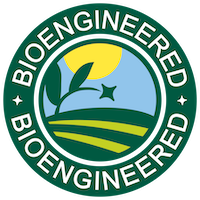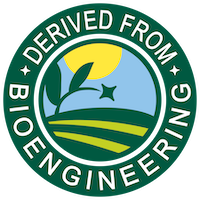Labeling Requirements for Bioengineered Ingredients
For years there was a lot of discussion in food circles about GMO and non-GMO ingredients and labeling. With the exception of a couple of states, any labeling was optional. But on January 1, 2022 the National Bioengineered Food Disclosure Standard (NBFDS) went into effect, and disclosure is the law of the land.
UPDATE: In October of 2024, we released a feature that detects bioengineered ingredients and allows you to easily make that disclosure on your labels. While this blog provides more in depth information about the regulation, we have a new blog that focuses on how our feature works.
What's being disclosed?
It's actually very specific. The USDA and FDA never liked the terms GMO or genetically modified organism because they found them vague and inaccurate. The correct terms are Bioengineered or BE food, and the USDA defines them as "those [foods] that contain detectable genetic material that has been modified through certain lab techniques and cannot be created through conventional breeding or found in nature." Anything meeting that definition must be disclosed.
Who has to disclose?
The disclosure requirement applies to all food manufacturers with annual receipts of $2.5M or more. Receipts include both food and nonfood items, and you can calculate them either by taking the average of your revenue for the 3 prior years or by taking the smallest revenue number from the same time period.
In addition to manufacturers, retailers who package food or sell food in a bulk container are responsible for ensuring that their packages have BE disclosures and their bulk displays or signs identify the food as BE. Importers are subject to the same disclosure and compliance requirements as domestic entities.
Who and what is exempt?
- Very small food manufacturers are exempt from the requirements of the NBFDS. “Very small” food manufacturers are defined as manufacturers with annual receipts below $2,500,000.
- Food that's served in restaurants or "similar retail food establishments" (think cafeterias, lunch rooms, food stands and trucks, etc.) is also exempt.
- Certified organic foods are by definition not BE and are exempt.
- Foods derived from animals don't become BE even if the animal is fed bioengineered food.
- And finally, there's an exemption for "food in which no ingredient intentionally contains a bioengineered (BE) substance, with an allowance for inadvertent or technically unavoidable BE presence of up to five percent (5%) for each ingredient."
How is the disclosure made?
The USDA has a helpful fact sheet, but here are the four disclosure options:
- A statement on the package such as “Bioengineered food” or “Contains a bioengineered food ingredient”
- One of the USDA's approved symbols for bioengineered food
- A link or QR code that "must include instructions to 'Scan here for more food information' or similar language that only reflects technological changes, and include the phrase 'Call [1-000-000-0000] for more food information'"
- A text message disclosure that includes the statement: “Text [command word] to [number] for bioengineered food information.”


The USDA's approved symbols for bioengineered foods
For small food manufacturers (defined as anyone with at least $2.5 M but less than $10 M in annual receipts) there's the additional option of providing a phone number or website. So the disclosure on the package would be “Call [phone number] for more food information” or “Visit [URL of the website] for more food information.”
The size of the package also opens more options. Disclosures on small packages (less than 40 square inches of surface area) may use shortened versions of the required statements. And disclosures on very small packages (less than 12 square inches of surface area) can be made using an existing URL or phone number.
Like all things in labeling, legibility is a big deal. The disclosure "must be of a sufficient size and clarity to appear prominently and conspicuously on the label, making it likely to be read and understood by the consumer."
Where must the disclosure be placed?
The placement is actually not too restrictive. The disclosure, in whatever form, must be on:
- The principal display panel
- The information panel adjacent to the business identity (manufacturer/distributor information) or
- If there isn't enough space on either of those panels, it can be on any other panel "likely to be seen by a consumer under ordinary shopping conditions."
If you want to see all the rules and regulations yourself, they are here.
How do I know if my product contains BE foods?
The Agricultural Marketing Service (AMS) created a list of BE crops that are available in the US and globally. AMS reviews the list annually and updates it, so keep an eye on it.
The current list is: Alfalfa, apple (ArcticTM varieties), canola, corn, cotton, eggplant (BARI Bt Begun varieties), papaya (ringspot virus-resistant varieties), pineapple (pink flesh varieties), potato, salmon (AquAdvantage®), soybean, squash (summer), and sugarbeet.
You should presume that in the US all soy, canola, and corn is BE unless it specifically says otherwise. There are some BE potatoes and summer squashes that are sold in the US, but they currently make up a small percentage of the overall crops and food supply.
Is there anything else that's required?
Regulated entities that use a food on the List of Bioengineered Foods are required to keep "customary and reasonable business records regarding the food." Some examples of the types of records that could be used are "supply chain records, bills of lading, invoices, supplier attestations, labels, contracts, brokers' statements, third party certifications, laboratory testing results, validated process verifications, and other records generated or maintained by the regulated entity in the normal course of business."
The records can be paper or electronic. They must be kept for at least 2 years after the food is sold or distributed.
The final word
We should be seeing many more BE disclosures on products in the stores because any company with more than $2.5 million in annual receipts making a product with any soy, canola, or corn in it that isn't explicitly not BE has to disclose. There are, however, many exceptions and exemptions in the USDA's rules, so whether or not we will is uncertain.
Those rules--the agency's interpretation and implementation of the NDFBS--are currently being challenged in a legal appeal.






